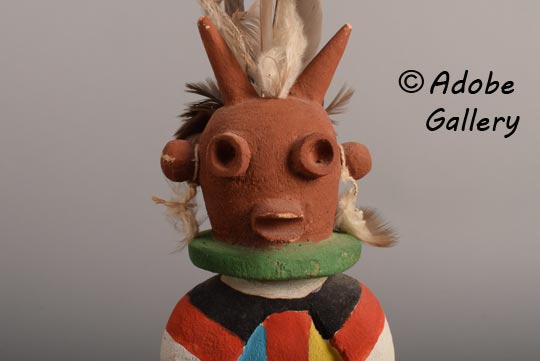Hopi Pueblo Koyemsi Mana Katsina Doll
+ Add to my watchlist Forward to Friend
Forward to Friend
- Category: Traditional
- Origin: Hopi Pueblo, Hopituh Shi-nu-mu
- Medium: wood, paint, feathers
- Size: 10” height
- Item # C4726B
- Price: $995
This Katsina doll, adorned with a female shawl but lacking the customary black dress, presents an intriguing mystery. It has been previously identified as the Koyemsi Mana, as indicated by an old tag attached to it. However, other possibilities suggest that it could represent the Kuikuinaka Koyemsi or even the Tuve Koyemsi, a Koyemsi dressed as another Katsina. The body paint adds another layer to this enigma.
The Koyemsi, adopted from Zuni Pueblo many decades ago, hold a significant place in both Hopi and Zuni cultures. Interestingly, the name ‘Koyemsi' itself is of Zuni origin, while the Hopi refer to these Mudhead figures as ‘Tachukti'. Contrary to their appearance, the Koyemsi are not considered Katsinas in either culture. Instead, they serve as interlocutors between Katsinas and humans, announcing impending events, translating requests, giving directions, and conveying other information.
The multitude of Koyemsi variants suggests a genre that is flexible and open to a variety of interpretations and representations. As Barton Wright illustrates in his book "Clowns of the Hopi", the Koyemsi are capable of change and innovation, with seemingly no limit to their functions and attire. This adaptability underscores the dynamic nature of these cultural figures and their enduring significance in Hopi and Zuni societies.
Condition: good condition. The tip of right toe was broken and has been professionally repaired.
Provenance: this Hopi Pueblo Koyemsi Mana Katsina Doll is from the collection of a client of the gallery
Reference: Wright, Barton. Clowns of the Hopi: Tradition Keepers and Delight Makers.
TAGS: Kachina – Katsina Doll, Hopi Pueblo

- Category: Traditional
- Origin: Hopi Pueblo, Hopituh Shi-nu-mu
- Medium: wood, paint, feathers
- Size: 10” height
- Item # C4726B
- Price: $995
Adobe Gallery Recommended Reading
Adobe Gallery Recommended Items
If you are interested in this item, we would also like to recommend these other related items:



